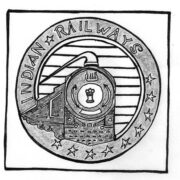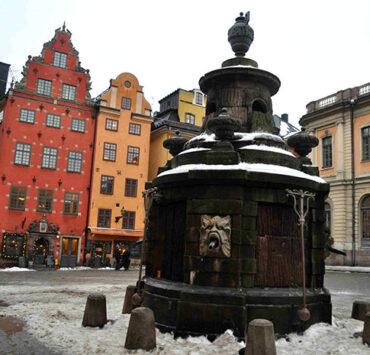To understand why I was only a little shocked—in an oh-my-god-you-had-sex-and-talked-about-it way, not a look-at-this-predator kinda way—when I read Nabokov’s Lolita at 16, you’d have to understand Indian culture.
Even after laws banning child marriage were passed in India, there’s still something that resides just under the surface of Indian society where, as soon as you start menstruating, you’re technically a woman, and therefore a sexual object. And since no one can really tell whether, or not, you’ve had your first period just by looking at you — they guess.
Like the man who would ride by on his bicycle while I was walking to school every morning, reach out, feel me up and cycle away. I was eleven, or twelve, at the time and it happened too quickly for me to have any reaction at all, except violation—in retrospect.

In India, girls are not only considered expendable, they are actually treated that way, over and over, in lots of ways. Illustration by Tara Isha.
You can’t blame the abduction and rape of a five-year-old—come on, Delhi—on Indian culture, right? Nor can you blame it for the fate of three sisters—aged six, nine, and eleven—who were sexually assaulted and thrown into a well in Maharashtra, and certainly not for the eight-year-old who was raped and murdered in Kanpur.
But we should.
In India, sons are wealth and daughters are a burden. The result is girls are not only considered expendable, they are actually treated that way, over and over, in lots of ways. Rape is just one. In India, girls are frequently killed—some inside the womb and some outside—because they are daughters, not sons. For those who survive, even in a country as inherently classist as India, a lower class man has far more power than an upper class woman.
Actually, let’s play a game.
Pick an age—any number—and put “raped” after it in a Google search and we’ll see if there are any results from India.
15-year-old? Done.
26-year-old? Done.
90-year-old? Unbelievable, but done.
There was even a story from 2004—doing the rounds on social media recently—about two men who raped a cow and the tremendous backlash they faced. Because, in India, cows are symbols of mothers, and therefore sacred; women, who are actual mothers, are dispensable.
People from other countries—when traveling through this one—sometimes toss my friends and me looks. They are usually dressed according to the guide book—long skirts, high neck t-shirts, anything to look like they’re not inviting trouble. Whereas, we’re in shorts, tank tops, even the more conservative among us pick skinny jeans and floaty tops. How to explain to these women that it’s not a local-versus-tourist double standard; they could just as easily get raped as us, but we simply refuse to hide?
How do you tell them the story of a former colleague walking back from a story—in the middle of the day, on a crowded road—when a car pulls up and someone tries to yank her in the backseat? She was wearing “modest” clothing.
“I will start a revolution with my cleavage,” I joked to someone who expressed concern about me walking around the city with a low neckline. I don’t want my outfit to be dictated by those hungry-eyed men who stand at Delhi street corners and look you up and down, murmuring obscenities.
My friend shook his head. “I don’t think the revolution should be led by you,” he said, wanting me to be safe. I left the house in the same outfit, but carried a cover up for when I got outside.
As far as revolutionaries go, I’m a bit of a scaredy-cat.
The other day, walking home from the market, in the twilight, I heard footsteps behind me, paced to my paces. I scampered, as one does, walking hurriedly, moving to the side of the road and waiting for whoever it was to overtake me. It was a small boy; he couldn’t have been more than 10 or 11. He strode past me without even meeting my eyes, late home to dinner. He got the message though: he, thanks to his gender, was more powerful than me on the streets.
After the horrific gang rape of a young student in Delhi in December, police and politicians have tried to care more about the largest minority India has—its women.
For a while, there were traffic jams till 11 at night as the cops put up barricades in the middle of main roads—barricades that were useless, because no one actually checked you, and just slowed everyone down while the cops chatted to each other, bored of this exercise. Ads about the Women’s Helpline played on the radio, but no one responded when you called.
Now, instead of looking you up and down, men look at you sullenly—you are the reason they were all so inconvenienced.
At a book reading I did in Pune, one male student asked if I was a feminist.
“Yes,” I said. “Aren’t you?”
He looked down, a shy, well-spoken chap, and then burst out with: “I think these laws are so unfairly biased! I haven’t done anything to women, why should I be punished? I think women are taking advantage of it.”
I realised then, I was face-to-face with the rest of my country: people who honestly, sincerely, didn’t get it. People who had never raped anyone, but couldn’t see why women in India were any more disadvantaged than the men. I suppose, to some, it now appears that women can move about with a certain impunity; we are never stopped by cops after 7 p.m., never questioned about our movements, and pandered to in a way men aren’t—with special “Ladies’s Compartments” in the trains and metro, and reserved seats on the bus, and so on.
I answered the student with the idea that women have had it bad for so long, that it would take some years of being given advantages before it could all even out. He wasn’t convinced.
In the meantime, here is what I—a thirty-one-year-old, independent woman living on my own in Delhi—have to do:
1. Text someone when I get home late to let them know I’m home safe.
2. Have someone walk me to my car, taxi, or rickshaw home after dark.
3. Carry a scarf to wrap around my shoulders over my clothes. (I call this a modesty scarf.)
4. Never let my phone die or people will think I died.
5. Only roll down my windows half-an-inch at night, in case someone tries to reach in my car window.
6. Watch out for people following me.
7. Never let on to random service people (carpenters, electricians, etc.) that I live alone.
8. Carry pepper spray.
9. Stay on the radar.
10. Be careful all the time.
It’s exhausting.
(This piece originally appeared on Medium on April 25, 2013.)
———
Read our recent interview with Meenakshi here.









very well written and excellent heading.